

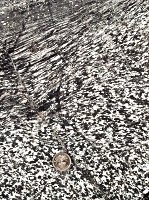 Many
rocks show more than just location fabric. Individual grains, rather than having near spherical shapes,
can be strongly flattened ellipsoids. Commonly the orientations of the strongly ellipsoidal
grains line up creating a new rock structure. In this case the fabric is defined by the shapes of grains
and so this type of organisation has the general name: SHAPE
FABRIC.
Many
rocks show more than just location fabric. Individual grains, rather than having near spherical shapes,
can be strongly flattened ellipsoids. Commonly the orientations of the strongly ellipsoidal
grains line up creating a new rock structure. In this case the fabric is defined by the shapes of grains
and so this type of organisation has the general name: SHAPE
FABRIC.
An aside: lines and planes; lineation and foliation.
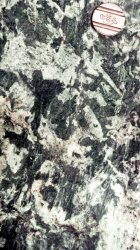 In
general the intensity of the shape fabric increases as the rock deforms. In some rocks this can happen
to such an extent that the original location fabric is impossible to see. Shape fabrics are important
to structural geologists because they allow some qualitative measure on the amount of deformation.
But they can also be used to understand geometrically how the rock has been distorted.
In
general the intensity of the shape fabric increases as the rock deforms. In some rocks this can happen
to such an extent that the original location fabric is impossible to see. Shape fabrics are important
to structural geologists because they allow some qualitative measure on the amount of deformation.
But they can also be used to understand geometrically how the rock has been distorted.
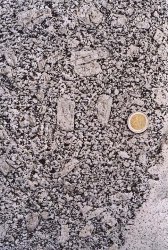 Consider
a ball of something soft - like plasticene. It has an original spherical shape. But this can be distorted
into ellipsoids of different shapes. The shapes of ellipsoids can be described in terms of the relative
lengths of the long axis, short axis and an intermediate axis (creating three dimensions with the axes
at 90º to each other). If you push straight down on it the plasticene becomes pancake-shaped. The technical
adjective for this is oblate. Here the short axis is reduced (of course) while the
intermediate and long axes are about the same (and increased). To a squash in one direction results
in a stretch in two directions. If a rock is made up of grains of this shape that are all aligned it
will have a strong PLANAR fabric.
Consider
a ball of something soft - like plasticene. It has an original spherical shape. But this can be distorted
into ellipsoids of different shapes. The shapes of ellipsoids can be described in terms of the relative
lengths of the long axis, short axis and an intermediate axis (creating three dimensions with the axes
at 90º to each other). If you push straight down on it the plasticene becomes pancake-shaped. The technical
adjective for this is oblate. Here the short axis is reduced (of course) while the
intermediate and long axes are about the same (and increased). To a squash in one direction results
in a stretch in two directions. If a rock is made up of grains of this shape that are all aligned it
will have a strong PLANAR fabric.
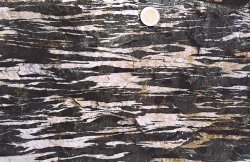 Now
let's imagine another experiment with our plasticene ball. Rather than squashing it we can draw it
out into a cigar shape. The technical adjective for this is prolate. Now the lump
has a single long axis and two short axes that are more or less equal. If a rock is made up of grains
that are all aligned it will have a strong LINEAR fabric. The rock itself would have the structure
of a bunch of pencils (or drinking straws).
Now
let's imagine another experiment with our plasticene ball. Rather than squashing it we can draw it
out into a cigar shape. The technical adjective for this is prolate. Now the lump
has a single long axis and two short axes that are more or less equal. If a rock is made up of grains
that are all aligned it will have a strong LINEAR fabric. The rock itself would have the structure
of a bunch of pencils (or drinking straws).
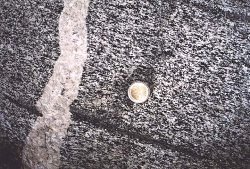 Finally
we can perform another experiment with our plasticene ball smearing it by moving our hand across it
on a table top. The ball will deform into an ellipsoid that is both flattened (increasingly parallel
to the table-top) and elongate in the direction we smear in. The ellipsoid now has three axes of different
length - rather like a pitta bread! In an ideal example the squashing in the direction of the short
axis is matched by an elongation in the direction of the long axis, with the intermediate axis remaining
unchanged. The technical term for this type of distortion is PLANE STRAIN.
Finally
we can perform another experiment with our plasticene ball smearing it by moving our hand across it
on a table top. The ball will deform into an ellipsoid that is both flattened (increasingly parallel
to the table-top) and elongate in the direction we smear in. The ellipsoid now has three axes of different
length - rather like a pitta bread! In an ideal example the squashing in the direction of the short
axis is matched by an elongation in the direction of the long axis, with the intermediate axis remaining
unchanged. The technical term for this type of distortion is PLANE STRAIN.
An aside: tectonites
The various types of shape fabric in rocks represent important information for understanding deformed rocks. These uses are described elsewhere.